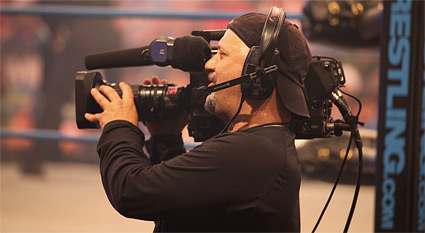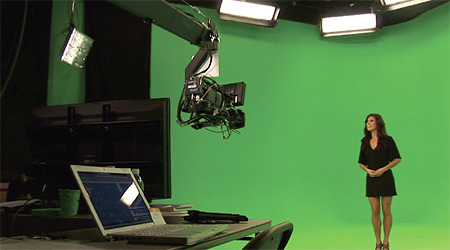The Challenge of Going Wide
SEATTLE: Anyone who has shot a lot of video over the years will tell you that for every time a little longer focal length lens would have been handy, there were a dozen situations where they were zoomed out wide, pressing their back into the wall, trying to get a little more of the scene into the shot.
When shooting NHRA drag racing for ESPN, mobile operator Crosscreek Television Productions requires plenty of long lenses on towers and head on to capture the action, but the cramped quarters at the starting line call for wide angle lenses. They use the Fujinon HA14x4.5.

Crosscreek Television Productions uses the Fujinon HA14x4.5 to cover TNA Wrestling on Spike. "That's exactly what the network wants," said Spruce McRee, national sales director for the Alabaster, Ala.-based mobile production company. "And they are a must for good jib shots. We also use them on our handheld cameras for professional wrestling events, since the shots are so close to ringside." He noted that clients also like them on a camera used for wide beauty shots.
"Each of our trucks carries at least one or two wide-angle zooms, and some even more," he said.
VIRTUAL NEEDS
Very wide-angle zoom lenses can be critical for deploying a virtual set, according to Christopher Mapes, vice president of engineering for Los Angeles-based Intertainment Broadcasting Corp. (iBC). "The folks who build and employ green screens on set do so usually because of space limitations," he said. "Those space limitations dictate that they build a smaller studio environment, and a smaller studio environment generally dictates a wide angle lens to maximize the space." Intertainment uses the Canon HJ14ex4.3B.
Mapes said that it's critical for the edges of the frame to be as perfect as possible when working with a virtual set. "We tend to keep our subjects in the sweet spot of the lens, because in virtual, what happens as I move my talent to the edge of frame, not every lens but a good amount of lenses will distort out in that last 10 percent, and it's a distortion that I can't account for mathematically with the [rendering] software.
"I look for consistency in a zoom lens, he continued. "So if I'm looking at zoom tracking and the collimation [lining up], I prefer that collimation be in one direction as opposed to changing direction in the middle of a zoom."
If Mapes has to make a choice, "I choose to error on the side of zoom tracking," he said. "If I can find a lens that's more consistent with its collimation direction, then I'll stay with that because the curves that are created by lens track are much more linear."
MANUFACTURING HURDLES
So what's the big deal about designing and building a high-quality wide-angle zoom lens? According to lens makers, wide-angle zooms are among the most challenging lenses to make, and they identify many of the same design and manufacturing hurdles that need to be crossed.

Virtual studio provider Intertainment Broadcasting Corp. uses the Canon HJ14ex4.3B on its virtual sets. "One of the hardest things with the wide-angle lens is that as you try to get wider and wider, it's more difficult to keep the vertical lines and horizontal lines straight," said Thom Calabro, director of marketing and product development at the Optical Devices Division of Fujifilm North America Corp.
Pointing to the example of a drop ceiling in the background, with rectangular ceiling tiles, Calabro noted that a wide angle lens will want to bow or curve the lines of those rectangles. "Of course the lines in the center are going to be fine, and even if your brain is telling you all these things are parallel, why are the lines that are all the way at the top and all the way at the bottom, and all the way at the sides, why do they have curves in them?" On the widest zoom lenses it's possible to remove such distortion, he said, "but it takes a lot to do it."
Larry Thorpe, Canon USA's senior fellow at the Imaging Technologies & Communications Group, Professional Engineering & Solutions Division, listed another critical factor for wide-angle lenses: "Maintaining a high MTF [Modulation Transfer Function] at picture extremities at the wide-angle setting. This is dealt with by innovative new optical designs [of both lens elements and element groups], new glass materials, and higher precision in manufacturing."
Thorpe also pointed to "minimizing the relative light distribution [fall-off in light transmission from picture center to corners], which is dealt with by novel optical compensations between lens groups."
Wide-angle zooms, with their large and highly curved front elements, require a lot of bending of light rays to resolve the picture on the imager. This increases the difficulty of reducing chromatic aberration, the failure of a lens to focus all colors to the same convergence point. "If you have chromatic aberration, you're going to see color fringing, or it's going to look soft, or a combination of both, depending on the aberration," said Calabro.
Thorpe added that in building their lastest, widest-angle zoom lens, "design criteria were further extended to minimize focus breathing and also to reduce ghosting and flare artifacts when severe highlights are encountered at the edge of frame, especially at the wide-angle setting."
Both Calabro and Thorpe credit advances in computer optical design software with making it possible to design their widest zooms with the standards necessary. Thorpe said Canon's 14x4.3 zoom "could not have been achieved a decade ago," when its predecessor 11x4.7 was developed.
Get the TV Tech Newsletter
The professional video industry's #1 source for news, trends and product and tech information. Sign up below.
